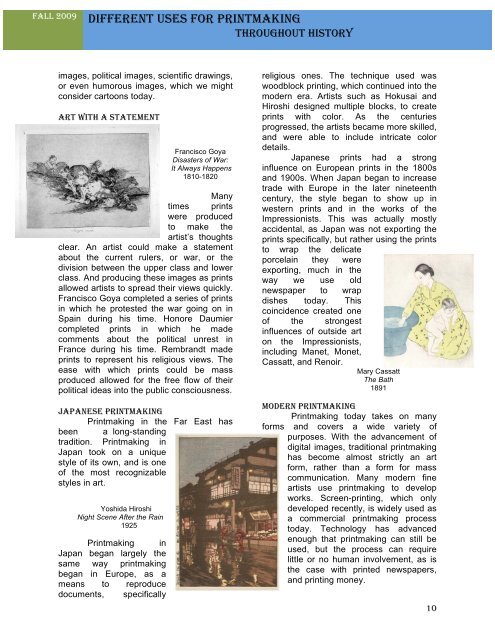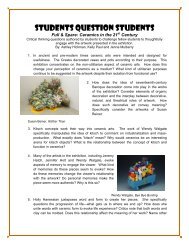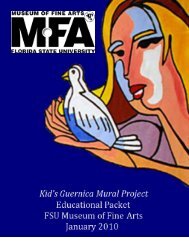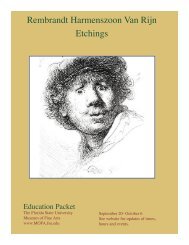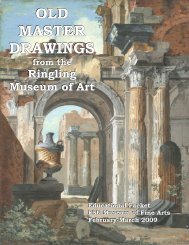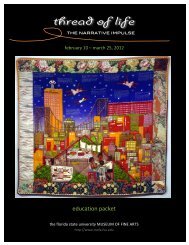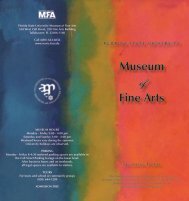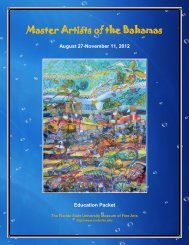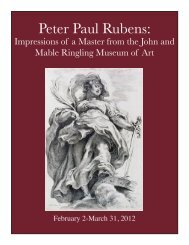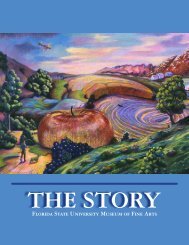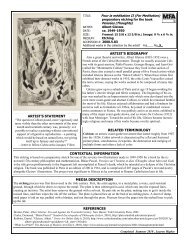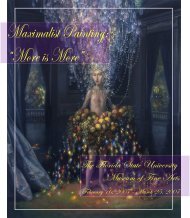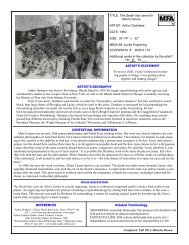Matrix: Contemporary Printmaking - Museum of Fine Arts - Florida ...
Matrix: Contemporary Printmaking - Museum of Fine Arts - Florida ...
Matrix: Contemporary Printmaking - Museum of Fine Arts - Florida ...
You also want an ePaper? Increase the reach of your titles
YUMPU automatically turns print PDFs into web optimized ePapers that Google loves.
Fall 2009<br />
Different uses for <strong>Printmaking</strong><br />
Throughout History<br />
images, political images, scientific drawings,<br />
or even humorous images, which we might<br />
consider cartoons today.<br />
Art with a Statement<br />
Francisco Goya<br />
Disasters <strong>of</strong> War:<br />
It Always Happens<br />
1810-1820<br />
Many<br />
times prints<br />
were produced<br />
to make the<br />
artist’s thoughts<br />
clear. An artist could make a statement<br />
about the current rulers, or war, or the<br />
division between the upper class and lower<br />
class. And producing these images as prints<br />
allowed artists to spread their views quickly.<br />
Francisco Goya completed a series <strong>of</strong> prints<br />
in which he protested the war going on in<br />
Spain during his time. Honore Daumier<br />
completed prints in which he made<br />
comments about the political unrest in<br />
France during his time. Rembrandt made<br />
prints to represent his religious views. The<br />
ease with which prints could be mass<br />
produced allowed for the free flow <strong>of</strong> their<br />
political ideas into the public consciousness.<br />
Japanese <strong>Printmaking</strong><br />
<strong>Printmaking</strong> in the Far East has<br />
been a long-standing<br />
tradition. <strong>Printmaking</strong> in<br />
Japan took on a unique<br />
style <strong>of</strong> its own, and is one<br />
<strong>of</strong> the most recognizable<br />
styles in art.<br />
Yoshida Hiroshi<br />
Night Scene After the Rain<br />
1925<br />
<strong>Printmaking</strong> in<br />
Japan began largely the<br />
same way printmaking<br />
began in Europe, as a<br />
means to reproduce<br />
documents, specifically<br />
religious ones. The technique used was<br />
woodblock printing, which continued into the<br />
modern era. Artists such as Hokusai and<br />
Hiroshi designed multiple blocks, to create<br />
prints with color. As the centuries<br />
progressed, the artists became more skilled,<br />
and were able to include intricate color<br />
details.<br />
Japanese prints had a strong<br />
influence on European prints in the 1800s<br />
and 1900s. When Japan began to increase<br />
trade with Europe in the later nineteenth<br />
century, the style began to show up in<br />
western prints and in the works <strong>of</strong> the<br />
Impressionists. This was actually mostly<br />
accidental, as Japan was not exporting the<br />
prints specifically, but rather using the prints<br />
to wrap the delicate<br />
porcelain they were<br />
exporting, much in the<br />
way we use old<br />
newspaper to wrap<br />
dishes today. This<br />
coincidence created one<br />
<strong>of</strong> the strongest<br />
influences <strong>of</strong> outside art<br />
on the Impressionists,<br />
including Manet, Monet,<br />
Cassatt, and Renoir.<br />
Mary Cassatt<br />
The Bath<br />
1891<br />
Modern <strong>Printmaking</strong><br />
<strong>Printmaking</strong> today takes on many<br />
forms and covers a wide variety <strong>of</strong><br />
purposes. With the advancement <strong>of</strong><br />
digital images, traditional printmaking<br />
has become almost strictly an art<br />
form, rather than a form for mass<br />
communication. Many modern fine<br />
artists use printmaking to develop<br />
works. Screen-printing, which only<br />
developed recently, is widely used as<br />
a commercial printmaking process<br />
today. Technology has advanced<br />
enough that printmaking can still be<br />
used, but the process can require<br />
little or no human involvement, as is<br />
the case with printed newspapers,<br />
and printing money.<br />
10


